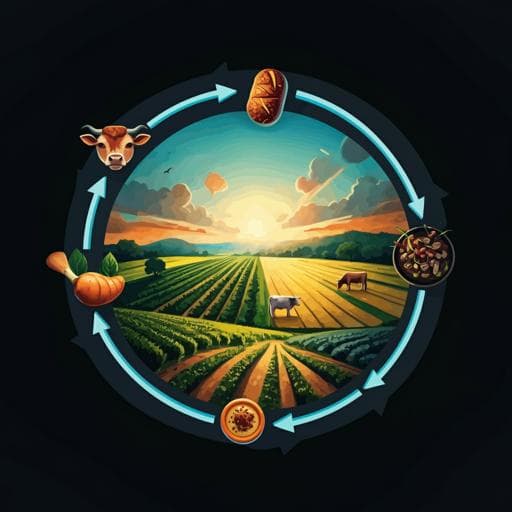
Food Science and Technology
Framework for evaluation of food safety in the circular food system
H. J. V. D. Fels-klerx, E. D. V. Asselt, et al.
This research by H. J. van der Fels-Klerx and colleagues explores a framework to assess food safety issues in circular food systems, demonstrating how recycling side streams from food production can impact hazard presence in final products. Discover insights from their case studies on animal manure and insect rearing!
~3 min • Beginner • English
Introduction
European food production is transitioning from linear to circular systems to reduce waste and valorise side streams (e.g., reusing by-products as inputs). While environmental and socio-economic benefits are expected, circularity can introduce food safety concerns: by-products without a history of safe use may contain unknown hazards; known hazards may appear at unexpected points; and chemical hazards at low levels in biomass can accumulate when loops are closed, potentially elevating levels in final foods. The key challenge is to maintain current food safety standards while closing production loops. This research aimed to develop a framework for a priori assessment of food safety during the transition to circular food production systems in Europe. Building on HACCP principles and EU General Food Law requirements, the framework focuses on the full supply chain rather than individual food business operators, and aligns with EU policy initiatives such as the Green Deal and Farm-to-Fork strategy. Results from applying the framework can guide actions to prevent human health risks.
Literature Review
Background sources cited indicate: pharmaceuticals used in livestock (antibiotics, antiparasitics, coccidiostats, hormones) can persist in manure and soil and be taken up by crops, and manure can carry foodborne pathogens (e.g., Salmonella spp., E. coli). Reviews report wide variability in occurrence and persistence across manure types and environments, and temperature-dependent persistence of pathogens in fields. Prior work identifies mobility (e.g., Koc) and half-lives (DT50) as key determinants for transfer and persistence of chemicals, and DALY-based severity scoring for pathogens. For insects reared on side streams, reviews show chemical accumulation depends on species, life stage, substrate, and rearing conditions; heavy metals (e.g., cadmium) can accumulate, whereas many pesticides and mycotoxins do not. Risk ranking literature supports integrating presence in foods and health effects using semi-quantitative classifications when data are limited.
Methodology
A three-step semi-quantitative framework was developed: (1) Describe the changes in the supply chain due to circularity versus a baseline linear chain, mapping stages, processes, and material flows affected by closing loops. (2) Identify potential food safety hazards (biological, chemical, physical) that may newly occur or increase due to the changes, using systematic review and/or expert elicitation. (3) Prioritise hazards by estimating human health risk as a function of their presence in final food products and the severity of health effects. Presence is assessed via: occurrence in raw materials (e.g., by-products, wastes, excreta), persistence in the environment or waste stream (chemical DT50; microbial decay and environmental conditions), and transfer/accumulation to edible parts of plants or animals (e.g., mobility via Koc for plant uptake; transfer factors/BAF/BCF for animals). Each indicator is classified as low/medium/high; combination rules (Table 9 in the paper) map these to an overall presence score. Health effects are classified using toxicological endpoints and guidance values for chemicals (ADI/TDI thresholds, with ADI/TDI > 10 µg/kg bw/day considered low, ≤10 considered high; carcinogenicity/mutagenicity/repro-toxicity/STOT RE signal high) and disease burden for microbes (DALY per case: <0.01 low; 0.01–0.1 medium; >0.1 high). Presence and health effect scores are combined to yield a prioritization level (low/medium/high). Uncertainty is explored by considering how changes in indicator scores would affect the final risk class. The framework was applied to three case studies representing typical circular transitions with available data.
Key Findings
Case study 1 (animal manure in horticulture): • Occurrence in raw manure (average ng/g dm): tetracyclines (cattle 40,805; poultry 30,166; swine 89,639), (fluoro)quinolones (cattle 7,900; poultry 92,696; swine 12,099), macrolides (cattle 40; poultry 3,836; swine 6,927), sulphonamides (cattle 1,277; poultry 10,591; swine 6,277). Pathogens (cfu/g dm): E. coli (cattle 1.3×10^8; poultry 2.2×10^7; swine 4.7×10^4), Salmonella (cattle 3.1×10^5; poultry 1.4×10^4; swine 3.7×10^3). • Persistence (DT50, days): antibiotics varied by manure type and soil; e.g., (fluoro)quinolones up to 564 days in cattle solid manure; in soils, (fluoro)quinolones 182 (sand), 97 (clay). Field pathogen decay times (1 log): ~12.6 days (E. coli), ~15.9 days (Salmonella). A 60-day pre-harvest interval implies a 4–5 log reduction → persistence for E. coli and Salmonella classified low. • Transfer: based on Koc, sulphonamides have higher plant uptake potential (log Koc ~0.5), whereas tetracyclines (≥3.0), (fluoro)quinolones (≥2.9), macrolides (≥2.0) have low uptake potential. Pathogen transfer to edible parts classified medium. • Health effects: antibiotics severity considered via ADI and contribution to antibiotic resistance; microbial severity via DALY (STEC-based for E. coli, Salmonella medium). • Prioritization: (fluoro)quinolones high; tetracyclines and E. coli medium; macrolides, sulphonamides, and Salmonella low. Case study 2 (rearing black soldier fly on side streams): • Occurrence: dioxins/PCBs low in household waste (~140 ± 20 pg/kg WHO-TEQ) and medium in manure (40–62.4 µg eq TCDD/L). Veterinary drugs high in manure (group worst-case), low in household waste. Pesticides low in both; heavy metals low in manure but higher in household waste (e.g., Cd 0.127 mg/kg; Pb 43.5 mg/kg). Mycotoxins in these substrates expected low. • Transfer/accumulation: cadmium accumulates in BSF larvae with BAF up to ~20; lead up to ~2.3; dioxins/dl-PCBs up to ~2; veterinary drugs generally do not accumulate and can be degraded (e.g., tetracyclines). Investigated mycotoxins and many pesticides do not accumulate; aflatoxins can be degraded. • Health effects: high severity for dioxins (TWI 2 pg/kg bw/week), cadmium (TWI 2.5 µg/kg bw/week), and lead (BMDL10 0.63 µg/kg bw/day). Pesticides generally low severity (ADI/ARfD >10 µg/kg bw/day). Tetracyclines low toxicity (JECFA). Aflatoxin B1 and DON have high severity guidance values, but low occurrence/accumulation here. • Prioritization: cadmium and lead high; dioxins/PCBs medium; aflatoxin B1, deoxynivalenol, tetracyclines/veterinary drugs, and pesticides low. Case study 3 (local production/shorter supply chains, Dutch wheat): • Scenarios compared: short-chain (one field) vs conventional (mix of 5–10 fields). • Occurrence (µg/kg, kernels at harvest): dataset medians/means/max (2009–2018) were DON median 60, mean 411, max 15,400; ZEA median 25, mean 65, max 2,000; T-2+HT-2 median 10, mean 11.7, max 66; %>ML: DON 6.1%, ZEA 6.9%, T-2+HT-2 0%. Simulation (100,000 draws): conventional had higher medians and %>ML for DON and ZEA than short-chain, but short-chain had higher maxima. • Persistence: high (mycotoxins largely not degraded in processing). • Transfer: high (processing factors to white flour: DON ~0.5–0.8; ZEA 0.1–0.9; T-2/HT-2 0.2–0.4; higher for wholemeal). • Health effects: high severity (TDIs: DON 1 µg/kg bw/day; ZEA 0.25 µg/kg bw/day; T-2/HT-2 0.02 µg/kg bw/day). • Prioritization: overall DON and ZEA high; T-2 and HT-2 medium.
Discussion
The framework supports proactive identification and prioritization of food safety hazards arising from circularity-related changes. Across the case studies, circularity affected the presence of hazards more than their intrinsic severity, with presence driven by occurrence in raw materials, persistence in environments, and transfer/accumulation to edible components. Semi-quantitative thresholds facilitate application when data are sparse and improve transparency and communication, though threshold choices are subjective and may influence classifications. The manure case illustrated the need to assume simplified transfer metrics (e.g., Koc) and persistence (DT50), while acknowledging dependencies on soil, crop, and chemical properties. The insect case showed that prioritization hinges on both substrate contamination and species-specific accumulation (e.g., heavy metals), whereas microbiological hazard data for insects are limited. The local wheat case highlighted that mixing (conventional chains) can dilute localized contamination, affecting exceedance probabilities and maxima differently between short and conventional chains; hazard priority was driven primarily by occurrence. While the framework enables within-case prioritization, cross-case comparisons are challenging because indicator sets can differ by case. Nevertheless, the approach is broadly applicable to diverse circular transitions and can guide risk managers to focus on hazards most likely to impact human health.
Conclusion
A practical, semi-quantitative framework was developed to identify and prioritize potential food safety hazards during transitions from linear to circular food systems. Applied to three representative cases, it demonstrated that circularity mainly affects hazard presence through persistence and transfer rather than changing health effect severity. The framework can be used at the design stage of circular interventions to prevent food safety issues by focusing risk management on high-priority hazards (e.g., (fluoro)quinolones in manure-to-horticulture, cadmium and lead in insect rearing on side streams, DON and ZEA in local wheat). Because relevant indicators are case dependent, applications should be case-by-case and refined as more data become available. Future research should improve data on occurrence, persistence, and transfer pathways in circular contexts, develop more quantitative models where feasible, and expand evidence on microbiological hazards in novel circular production systems (e.g., insects).
Limitations
Key limitations include: reliance on limited and heterogeneous secondary data; subjective classification thresholds for low/medium/high categories; simplified transfer and persistence estimates (e.g., using Koc for plant uptake, DT50 values without full environmental context); case-specific indicator selection hindering cross-case comparability; scarcity of data on microbiological hazards in insect rearing; and assumptions about waiting times and environmental conditions (e.g., temperature-dependent persistence). These factors introduce uncertainty in presence and risk classifications and underscore the need for more detailed, quantitative assessments as data improve.
Related Publications
Explore these studies to deepen your understanding of the subject.







